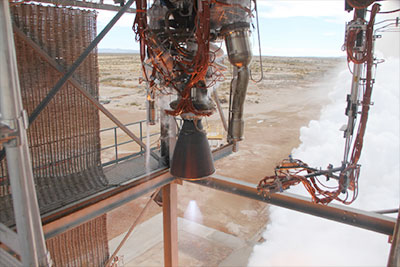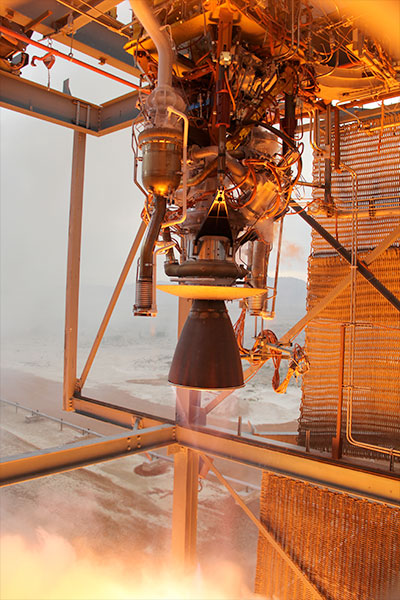|
|

|
 |
| Forum: | Commercial Space - Military Space |
| Topic: | Blue Origin New Shepard BE-3 rocket engine |
|
| Want to register?
|
If you have previously registered, but forgotten your password, click here.
The test demonstrated a full mission duty cycle, mimicking flight of the New Shepard vehicle by thrusting at 110,000 pounds in a 145-second boost phase, shutting down for approximately four and a half minutes to simulate coast through apogee, then restarting and throttling down to 25,000 pounds thrust to simulate controlled vertical landing. To date, the BE-3 has demonstrated more than 160 starts and 9,100 seconds of operation at Blue Origin's test facility near Van Horn, Texas. Designed and developed in-house by Blue Origin at the company's research and development center outside Seattle, the BE-3 features a "tap-off" design, in which the main chamber combustion gases are used to power the engine's turbopumps. Tap-off is particularly well-suited to human spaceflight because of its single combustion chamber and graceful shutdown mode.  "The BE-3 will gain extensive flight heritage on our New Shepard suborbital system prior to entering service on vehicles carrying humans to low-Earth orbit," said Rob Meyerson, president and program manager of Blue Origin. "Given its high-performance, low cost, and reusability the BE-3 is well suited for boost, upper-stage and in-space applications on both government and commercial launch systems." Blue Origin previously conducted testing of the BE-3 thrust chamber in partnership with NASA's Commercial Crew Program, as part of a long-term vision to provide safe, affordable crew transport to low-Earth orbit. | | Robert Pearlman | Blue Origin release Blue Origin Completes Acceptance Testing of BE-3 Engine for New Shepard Suborbital FlightBlue Origin recently completed acceptance testing of its BE‑3 rocket engine, the first new hydrogen engine to be developed in the United States in more than a decade. The 110,000-lbf BE‑3 will power Blue Origin's New Shepard suborbital system, and later, will be modified for upper stage applications. "The BE‑3 has now been fired for more than 30,000 seconds over the course of 450 tests," said Jeff Bezos, Blue Origin founder. "We test, learn, refine and then test again to push our engines. The Blue Origin team did an outstanding job exploring the corners of what the BE‑3 can do and soon we'll put it to the ultimate test of flight."  The BE‑3 can be continuously throttled between 110,000-lbf and 20,000-lbf thrust, a key capability for vertical takeoff and vertical landing vehicles. The testing profile included multiple mission duty cycles, deep throttling and off-nominal test points. "Liquid hydrogen is challenging, deep throttling is challenging and reusability is challenging," said Bezos. "This engine has all three. The rewards are highest performance, vertical landing even with a single-engine vehicle and low cost. And, as a future upper stage engine, hydrogen greatly increases payload capabilities." The BE‑3 engine was designed and fabricated at Blue Origin's design, development and production facility in Kent, Wash. Full-engine testing was conducted at the company's facilities in West Texas, while earlier combustion chamber testing was completed at NASA's Stennis Space Center in Mississippi. The BE‑3 is the third generation of Blue Origin-developed engines. The fourth-generation BE‑4 uses liquid oxygen and liquefied natural gas (LNG) to produce 550,000-lbf thrust at sea level. Under development since 2012, the BE‑4 provides the lowest cost and fastest production path to power the nation's access to space. Selected by United Launch Alliance to serve as the primary propulsion provider for its Next Generation Launch System, Blue Origin is developing the BE‑4 as an integrated part of America's newest launch vehicle. | |



